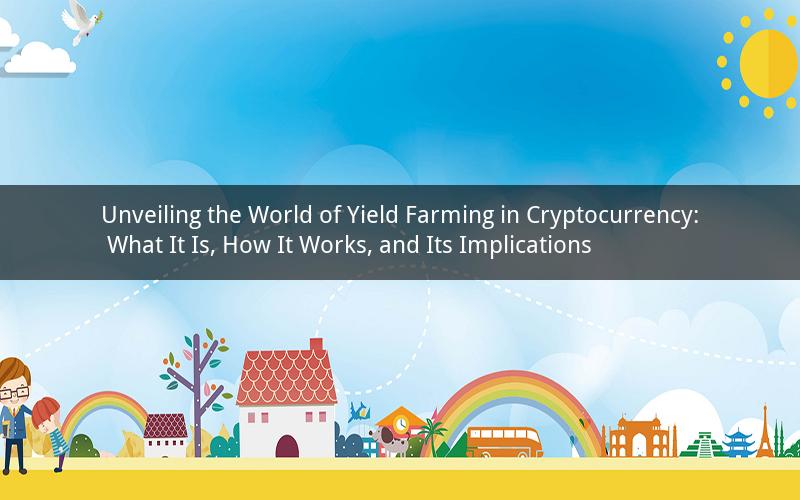
Introduction:
Yield farming has emerged as a popular concept in the cryptocurrency world, offering investors an opportunity to earn substantial returns on their holdings. This article delves into the intricacies of yield farming, exploring what it is, how it works, and its implications for the cryptocurrency market.
What is Yield Farming?
Yield farming, also known as liquidity mining, is a decentralized finance (DeFi) strategy that involves lending or providing liquidity to various blockchain platforms in exchange for rewards. It is a way for investors to earn interest or fees in the form of cryptocurrencies by participating in decentralized applications (DApps) or lending platforms.
How Does Yield Farming Work?
Yield farming operates through a simple mechanism. Investors lend their cryptocurrency assets to a DeFi platform, which then uses these assets to generate yield. The platform rewards the investors with additional cryptocurrency tokens based on their contribution and the performance of the platform.
1. Choosing a Platform:
Investors need to select a yield farming platform that aligns with their preferences and risk tolerance. Popular platforms include Uniswap, Aave, and Compound. Each platform offers different opportunities and rewards, so it's crucial to research and compare them.
2. Depositing Liquidity:
Once an investor has chosen a platform, they need to deposit their cryptocurrency assets into the platform's liquidity pool. This liquidity pool is used by the platform to facilitate trades and lend assets to borrowers.
3. Generating Yield:
The platform uses the deposited assets to generate yield through various activities, such as lending, borrowing, or trading. Investors earn rewards in the form of additional cryptocurrency tokens based on their contribution to the liquidity pool.
4. Harvesting Rewards:
After a certain period, investors can harvest their rewards by withdrawing their principal investment along with the earned tokens. The rewards can be reinvested into the platform for further gains or traded on exchanges for fiat currency.
5. Risks Involved:
Yield farming carries certain risks that investors should be aware of. These include smart contract vulnerabilities, regulatory concerns, and market volatility. It is essential to conduct thorough research and understand the risks associated with each platform and investment.
Implications of Yield Farming:
Yield farming has several implications for the cryptocurrency market:
1. Increased Liquidity:
Yield farming attracts a large number of investors to participate in DeFi platforms, leading to increased liquidity. This, in turn, enhances the overall stability and efficiency of the cryptocurrency market.
2. Growth of DeFi Ecosystem:
Yield farming has played a significant role in the growth of the DeFi ecosystem. It encourages innovation and the development of new DeFi projects, further expanding the possibilities within the cryptocurrency space.
3. Increased Competition:
As yield farming gains popularity, it leads to increased competition among DeFi platforms. This competition drives the platforms to offer better rewards and innovative features, ultimately benefiting investors.
4. Regulatory Challenges:
Yield farming raises regulatory challenges due to its decentralized nature. Governments and regulatory bodies around the world are still figuring out how to regulate this emerging space, which may lead to potential legal uncertainties.
5. Potential for High Returns:
Yield farming offers the potential for high returns on investment. However, it is crucial to note that these returns come with higher risks, and investors should exercise caution when engaging in yield farming.
Frequently Asked Questions (FAQs):
1. What is the difference between yield farming and staking?
Yield farming involves lending or providing liquidity to DeFi platforms in exchange for rewards, while staking is the process of locking up cryptocurrency assets to validate transactions and earn rewards on a blockchain network.
2. Can I participate in yield farming with any cryptocurrency?
Yes, you can participate in yield farming with various cryptocurrencies, including Bitcoin, Ethereum, and altcoins. However, it is essential to check the specific requirements and limitations of each platform.
3. How do I calculate the potential returns from yield farming?
To calculate potential returns from yield farming, you need to consider the interest rate or rewards offered by the platform, the duration of the investment, and the value of the cryptocurrency you are lending or providing liquidity to.
4. Is yield farming safe?
Yield farming carries risks, including smart contract vulnerabilities and market volatility. It is crucial to conduct thorough research, understand the risks involved, and only invest what you can afford to lose.
5. Can I yield farm on a centralized exchange?
While it is possible to engage in yield farming on certain centralized exchanges, it is generally recommended to use decentralized platforms for higher security and transparency.
Conclusion:
Yield farming has revolutionized the cryptocurrency market by offering investors a unique opportunity to earn substantial returns on their holdings. Understanding the mechanics, risks, and implications of yield farming is crucial for investors looking to participate in this exciting space. Conduct thorough research, exercise caution, and stay informed to navigate the world of yield farming successfully.